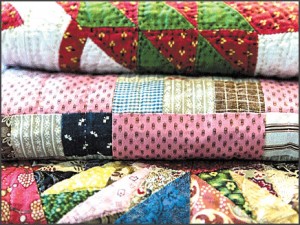If fact is truly stranger than fiction, then why do so many myths evolve into “facts?” Take for example the many misconceptions surrounding one of the most popular of folk art staples, the quilt. There are dozens of folklore stories surrounding the American quilt makers and their beautiful creations but I have selected my five favorites to share this week. Let’s see if you have heard any of these.
Myth: In colonial America (1620-1780} quilting was a daily chore for most housewives.
Fact: In actuality, quilting was a pastime reserved for the very wealthy. Why? Because they were the only ones who could afford the elaborate imported fabrics and expensive thread required to construct a quilt. It is also important to note that they had servants to do the menial household chores, affording them the time for such an indulgence as quilting. In the average colonial household, spinning, weaving and sewing kept the women busy. Add to those chores candlemaking, food preservation, gardening, educating the children and cooking for large families and you begin to see why “sitting by the hearth quilting” was not really a option. It would not be until the late 1840s that textiles began to be produced here in America and quilting became an option in the average household.
Myth: There were a number of specially designed quilts that were used to signal slaves using the Underground Railroad to escape to freedom.
Fact: I always thought this to be true, until I tried to research it. There appears to be no evidence of quilts being used as signals, codes or maps. It is thought that this myth came into being based on the significant number of patterns designed to commemorate political events that took place during this time in our nation’s history. The “Underground Railroad Block,” Jacob’s Ladder,” and the “Underground Railroad Doll Quilt” are three of the more popular. The stories of housewives hanging quilts on their clothesline to assist with slaves migrating north is a wonderful bit of folklore, but that is all it is.
Myth:If you find cotton seeds in the batting of a quilt it is validation that the quilt is an antique.
Fact: While this claim makes perfect sense on the surface, it is not accurate. The cotton seed is about the size of a pea and is very rough and nubby in texture, making it easily detectable. What is most commonly found in the batting of a quilt is the debris from cotton hulls. These are a common find in quilts of all ages and do not in any way assist with the determination of the age of the piece.
Myth: The “scrap quilt” originated during hard times as women clipped tiny pieces of fabric where ever they could and painstakingly formed them into quilts.
Fact: The exact opposite is true. Scrap quilts were made when fabric was plentiful. This bright and colorful style of quilt became popular in the early 1850s when American companies began to make affordable fabric as a result of the Industrial Revolution. Garment production in the home increased dramatically and as a result there was an abundance of leftover scrap.
Myth:The fabulous quilters of the Amish settlements made intentional mistakes in their quilts as a show of humility.
Fact: While it is true that the women of the Amish community were devoutly religious as well as being considered some of the most talented quilters of their day, they would probably be the first to admit that most every quilt has flaws. Rumor circulated that they intentionally made errors in their quilting to honor God, the Creator, as the only source capable of perfection. This is a wonderful story (and may have aided in selling many an Amish quilt), but it is in actuality just a myth. Until next time . . . Linda
Linda Kennett is a professional liquidation consultant specializing in down-sizing for seniors and the valuation of estates and may be reached at 317-258-7835 or lkennett@indy.rr.com



